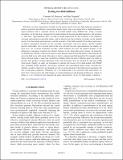Testing two-field inflation
Author(s)
Peterson, Courtney M.; Tegmark, Max Erik
DownloadPeterson-2011-Testing two-field in.pdf (8.630Mb)
PUBLISHER_POLICY
Publisher Policy
Article is made available in accordance with the publisher's policy and may be subject to US copyright law. Please refer to the publisher's site for terms of use.
Terms of use
Metadata
Show full item recordAbstract
We derive accurate semianalytic formulas for the power spectra from two-field inflation assuming an arbitrary potential and arbitrary noncanonical kinetic terms, and we use them both to build phenomenological intuition and to constrain classes of two-field models using WMAP data. Using covariant formalism, we first develop a framework for understanding the background field kinematics and introduce a “slow-turn” approximation. Next, we find covariant expressions for the evolution of the adiabatic/curvature and entropy/isocurvature modes, and we discuss how the evolution of modes can be inferred mostly from the background kinematics and the geometry of the field manifold. From these expressions, we derive semianalytic formulas for the curvature, isocurvature, and cross spectra, and the standard spectral observables, all to second order in the slow-roll and slow-turn approximations. In tandem, we show how our covariant formalism provides useful intuition into how the general features of the inflationary Lagrangian translate into distinct features in the observable power spectra. In particular, we find that key features of the power spectra can be directly read off from the nature of the roll path, the curve the field vector rolls along with respect to the two-dimensional field manifold. For example, models whose roll path makes a sharp turn around 60 e-foldings before the end of inflation tend to be ruled out because they produce stronger departures from scale invariance than are allowed by the latest CMB observations. Finally, we apply our formalism to confront four classes of two-field models with WMAP data, including doubly quadratic and quartic potentials and nonstandard kinetic terms, showing how whether a model is ruled out or not depends not only on certain features of the inflationary Lagrangian, but also on the initial conditions. Ultimately, for a two-field model to be consistent with observations, we show that it must possess the right balance of certain kinematical and dynamical behaviors, which we reduce to a set of functions that represent the main characteristics of any two-field model of inflation.
Date issued
2011-01Department
Massachusetts Institute of Technology. Department of Physics; MIT Kavli Institute for Astrophysics and Space ResearchJournal
Physical Review D
Publisher
American Physical Society
Citation
Peterson, Courtney M., and Max Tegmark. “Testing Two-field Inflation.” Physical Review D 83.2 (2011) : 023522. © 2011 American Physical Society
Version: Final published version
ISSN
1550-7998
1550-2368